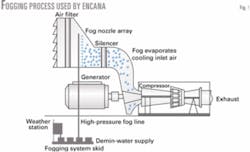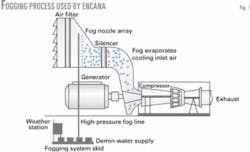Canadian gas plant uses new turbine cooling technique
Operations at a Canadian gas plant found fogging units added to turbines effective in cold climates as well as hot. While this may appear to be an obvious choice for operations in the hot, dry areas of the Southwest US, it also has proven effective at the EnCana Corp., Calgary, Caribou Lake gas plant in Alberta.
EnCana is using a refinement of inlet fogging called overspray (or intercooling) that is bringing even greater efficiencies to gas turbines in all types of climates.
Heat losses
Gas turbines move a constant volume of air, but they depend on the mass of that air for their power. To increase the available mass, turbines have as many as 17 stages that gradually compress the air before it reaches the burner. Denser air allows the turbine to burn more fuel and perform more work.
As temperatures rise, however, incoming air becomes less dense. Compounding the problem, hot air takes more energy to compress than cold air, resulting in a further drop off in turbine efficiency. Every 1° C. rise in ambient temperature reduces output by 0.54-0.90%.
"The performance of heavy-duty industrial gas turbines is greatly affected by the temperature of the air at the inlet to the compressor," says Scott Cloyd, director of engineering for Caldwell Energy & Environmental Inc., Geneva, Fla.
"At high ambient operating temperatures, the power levels can be reduced by 10-17% of a gas turbine's published ISO ratings due to the reduction in the density of the inlet air."
To address this problem, engineers have developed a variety of methods over the years to lower the air temperature. These include the use of chillers—an effective but expensive option—and media-type coolers (swamp coolers) that rely on water evaporation to lower the temperature.
Inlet fogging equipment has been used in recent years because it is less expensive to install and operate than a chiller, and it is more compact and easier to control than a media cooler.
"Fogging is a cheap way to add capacity when you need it, especially during hot days of summer," says Leonard Angello, manager of combustion turbine technology for the Electric Power Research Institute, Palo Alto, Calif. "It tends to give the biggest bang for the dollar."
There is one advantage that chillers have compared with evaporative methods. Coolers and traditional fogging systems can only lower the air temperature to the point where the air reaches 100% humidity, whereas chillers can reduce it even further, particularly in humid environments.
At least that used to be the case.
As fogging units became more popular, engineers began experimenting with pushing the envelope on how much cooling they could get. One of the assumptions challenged was that the water needed to evaporate 100% before entering the turbine because unevaporated water droplets would hit and damage the compressor blades.
Experience and further research, however, showed that small droplets, less than 10 mm in diameter, were safe; only the larger ones had the potential to cause damage. With properly designed and maintained equipment that produces small enough droplets, it is possible to oversaturate inlet air safely.
This led to the development of intercooling, also known as "wet compression" or "overspray." With this method, fogging is no longer limited by the ambient humidity. The equipment used is identical to conventional fogging, but the controllers are programmed to inject more water into the air than will evaporate before the air hits the turbine inlet.
When EnCana installed a fogging system at its Caribou Lake gas plant, about 200 miles northeast of Edmonton, the company opted for intercooling.
The facility consists of a gas gathering system with dehydration and compression. It produces more than 200 MMcfd of sweet natural gas.
Although the temperatures are below zero for much of the year, and summertime highs barely reach into the 70s, there is still enough cooling potential to make it worthwhile to install a fogging system.
For gas extraction, EnCana uses a Ruston Tornado 6.2 Mw turbine built now only on request by Alstom Power Ltd. To improve the turbine's output, the company chose a fogging system from Mee Industries Inc., Monrovia, Calif. (Fig. 1).
The system includes a water purification system so that no dissolved minerals foul the compressor blades, a high-pressure triplex pump from CAT Pumps, Minneapolis, and impaction pin nozzles in the fogging array. It uses stainless steel piping to prevent corrosion and erosion.
Intercooling advantages
Intercooling offers two distinct advantages compared with normal fogging. First, as the air heats up while moving through the compressor stages, the remaining water evaporates, which slightly recools the air temperature.
This means the turbine expends less energy in compressing the air. The pro-cess can increase output by as much as 10% without burning any additional fuel.
The second advantage is environmental. The cooler air often lowers the amount of NOx that the turbine produces.
Despite these advantages, there are two potential problems. The first is uneven cooling of the air inside the turbine, and the second is large droplets striking and damaging the compressor blades. Proper equipment design, however, solves both of these problems.
"Any additional nozzles added for intercooling should be installed in the same location as the primary fogging nozzles rather than using a second set nearer the inlet," says Ross Petersen, a gas turbine specialist with Mee Industries Inc. "This gives more time for the air to mix, resulting in more-even cooling."
This also addresses the droplet-size problem. Wind tunnel tests demonstrate that nearly all agglomeration of small droplets into larger ones occurs when they collide right after leaving the nozzle. Once the droplets are moving along with the air flow, such collisions are rare.
By the nozzles being placed far enough from the turbine inlet, its large droplets have time at least to evaporate partially before entering the machine, lowering any possibility of damage.
The author
Drew Robb ([email protected]) is a Los Angeles-based writer specializing in engineering and technology. He majored in geology at the University of Strathclyde in Scotland in 1978. Since then, he has pursued a writing career in both the UK and the US. He is president of Robb Editorial.


